-
Posts
270 -
Joined
-
Last visited
Content Type
Profiles
Forums
Store
Help Articles
Posts posted by Baron d'Apcher
-
-
Julbord. Swedish Christmas buffet.
Tre Sorters sill Three kinds of herring
Matjes sill Soused herring
Rökt lax Smoked salmon
Sill salad Herring salad
Grav lax Cured salmon
Jansons frestelse Janson’s temptation
Prins korv Prince sausage
Julskinka Christmas ham
Köttbullar Swedish meatballs
Rödkål Red cabbage
Rödbetor Pickled beets
Gurksallad Cumucber salad
Lingon Lingonberries
Ris a là Malta Rice porridge
Små kakor Small cookies
Linie akvavit, chilling.

Herring and salmon varieties.
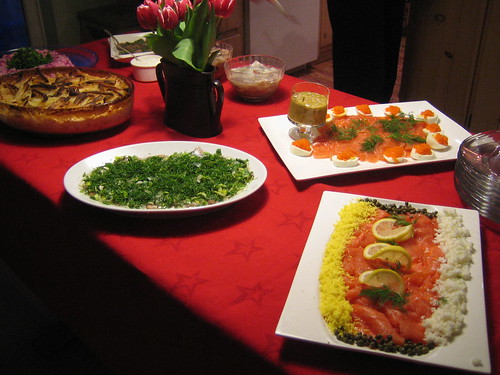
Christmas ham in Swedish aspic.
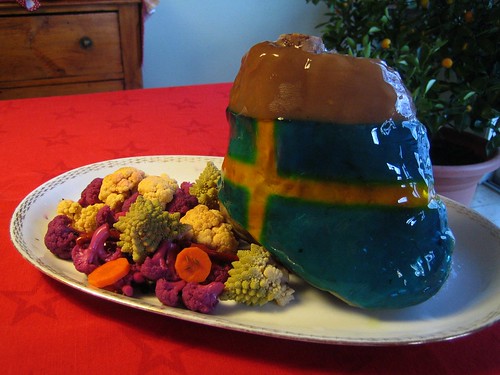
Sweets.
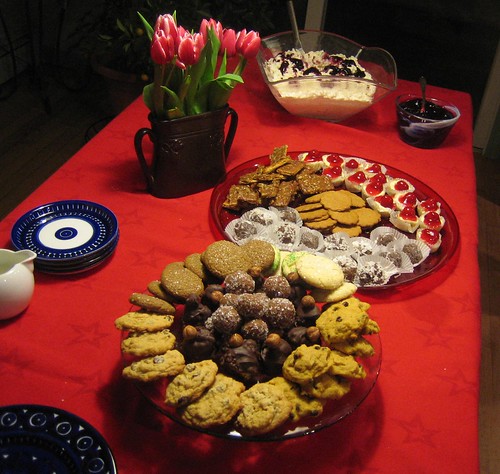
-
The plating of dishes prior to service is a streamlined version of Russian style service and consistent with the austere opulence of the “Nouvelle Cuisine” ethos, though it depends on what one considers to be “Nouvelle Cuisine”. The term recycled itself throughout history, used by La Chapelle in the 18th Century and Escoffier 150 years later. The current accepted period of “Nouvelle Cuisine” coined by Gault-Millau would be post WWII with the initial progenitor being Fernand Point, then perpetuated 20 years later by Bocuse, Chapelle, Troisgros Bros, Guérard, Vergé and Senderens.
There are 3 fundamental styles of dinner service:
à la Française (French) -buffet
à l’Anglaise (English) –efficiently passed buffet
à la Russe (Russian) –tableside plated showmanship
Whatever the case, plated “Russian” service goes back to 19th century and was introduced to the French by Prince Alexandre Kourakine, Russian ambassador to France from 1808-1812. Until then dainty French meals were served in the French manner –luxurious buffets or Buca di Beppo "family style” though often going cold and losing their aesthetics upon being served. Russian service however ensured hot food being served hot and more attention given to the plating of each dish with large joints of meat often presented whole (as is still done in upper tier restaurants) and then either plated in the kitchen or carved tableside. The English manner, oft preferred for banquets, involved a server serving food from a platter from the left with the help of utensils or tongs but sacrificed delicate plating attention.
The liabilities of Russian service were that the extravagance demanded a highly skilled and large staff. Contemporary Nouvelle Cuisine was lighter than the traditional cream & butter stalwart recipes and consequently such smaller, lighter, humbler portions demanded more plating artistry to satisfy the dining guest as opposed to the starchy yet spectacularly flamboyant presentations of yesteryear, the likes of which I passionately research and attempt to revive.
-
In lieu of rooster, "Poule au Pinard." An older hen's legs halved, marinated in thrifty red wine and aromatics (mirepoix, bay leaf, chili, star anise, peppercorns) for 5 days. The drained legs were browned in lard, followed by the caramelization of said aromatic garnish, tomato purée, splash of vinegar, some flour, the strained wine marinade and such and such. Braised until tender, strained and the liquid augmented by carrots, celery, onion sweated in with smoked pork jowl lardons, blanched potatoes and mushrooms. The delicate vanilla notes of red wine and land based proteins are nothing short of enjoyable.
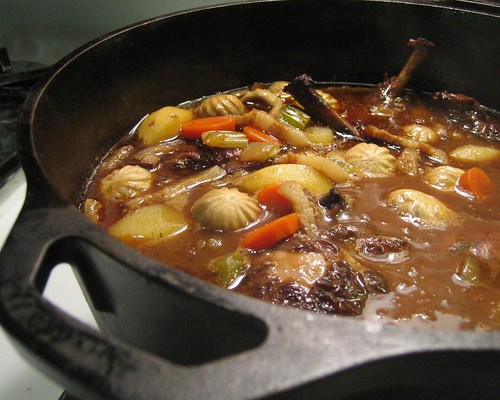
-
I'm going to make some Nuremberg brats...
For a party celebrating my sister's 18-month move to Berlin, a German tubesteak primer was in order. After some research 3 non-smoked varieties were chosen due to a flawed file cabinet smoker that smoked the apartment more than anything else. Prototypes were made.
Clockwise from the top: Bierschinken, beef rindswurst and Nürnbergen rostbratwurst.
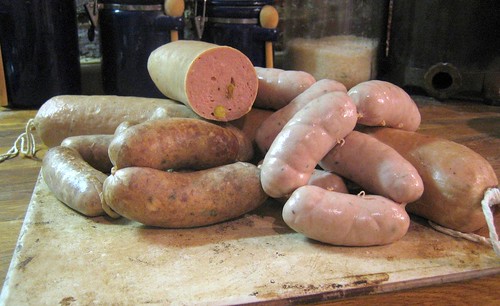
The emulsified bierschinken was twice ground pork shoulder puréed in a food processor with onions cooked in lard and iced water. Pistachios, raw chunks of pork (forgot to put enough aside), salt, and #1 were added as well as a small amount of paprika to ensure a rosy color. Stuffed into 2 beef middles and poached in a fish poacher until an internal temp of 150F was attained. Good results but need more chunks of pork. Served at room temperature. Tender, moist and properly seasoned.
Beef rindswurst required twice ground beef (chuck and rib-eye erroneously sold as chuck at a Latino market)puréed with iced water and onions cooked in veal tallow with caraway seeds. Emulsified as well, not unlike the Frankfurter. Salt and #1 were added though in hindsight the iced water should have been supplemented by paprika and tomato paste to maintain a deeper red color rather than the drabbish brown. The meat was stuffed into hog casings and poached, cooled then grilled the next day. The casings provided a nice "snap" and the rindswurst texture was pleasant with a whisper of caraway.
Nürnbergen rostbratwurst consisted simply of pork shoulder ground with some more of the onions cooked in lard (for moisture). The forcemeat was seasoned with the appropriate caraway and marjoram along with traces of cardamom and mace, salt and #1. Grilled from raw and not too shabby tastewise.
The lot was accompanied by a jar of repollo curtido (Salvadoran pickled cabbage in lieu of sauerkraut which would not have been ready in time), whole grain mustard and pickled cauliflower (romanesco, yellow and purple) using 24% Swedish ättiksprit since the 25% German essig was not readily available.
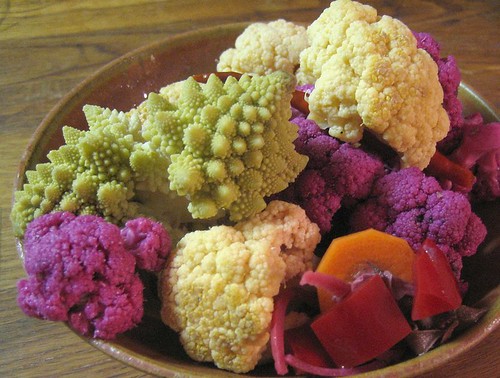
-
Le Répertoire de la Cuisine offers tangible ingredient foundations for the anecdotal regional/historical suffixes to such classical recipe appellations.
-
When did aspic stop becoming a fashionable and delightful party treat and start becoming a synonym for "incredibly vile"?
In this hemisphere aspic fell into kitschy Jell-O applications such as the venerable Ring around the Tuna Jell-O mold with inlaid iceberg lettuce.
There are more appealing uses of aspic. Consider last New Year’s day suckling ham with leek, carrot and truffle and some stuffed chicken legs in chaud-froid.
Jambon de porcelet en aspic.
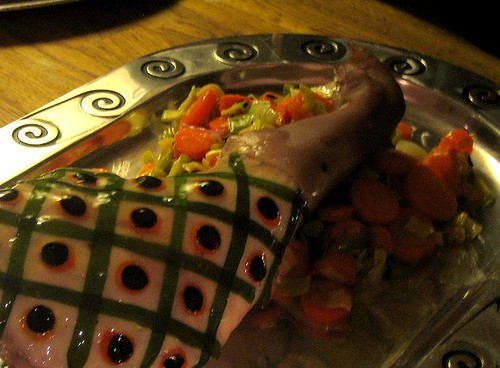
Jambonneau de volaille en chaud-froid.

-
Old World France meets New World America.

Preamble of my Mt. Pleasant dry cured sausage, turkey pâté en croûte with currants, a friend’s blood pudding and some Nîmes style brandade. Pickled purple cauliflower accoutrement and mulled cider adulterated with a trickle of George Dickel whisky to warsh it all down, then a bit more for social lubricant.

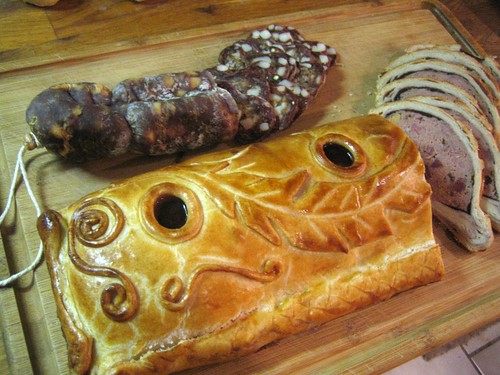
*Consommé du Barry. Turkey consommé from turkey parts from the neighborhood Latino grocer, with a few cauliflower-mornay agnolotti swimming around and florets of different cauliflower varieties clearly visible at the bottom.
*Scalloped potatoes sandwiching a middle layer of caramelized onions and anchovies.
*My rye bread, as a stuffing with pomegranate seeds, celery root, celery stalks and their leaves.
*Pear roasted heritage turkey breast. Roasted on the bone on a bed of pear scraps with shingled bosc pear slices under the skin, basted with pear juices.

"Pan Coudoun". Little breads, stuffed with a wedge of cooked quince.
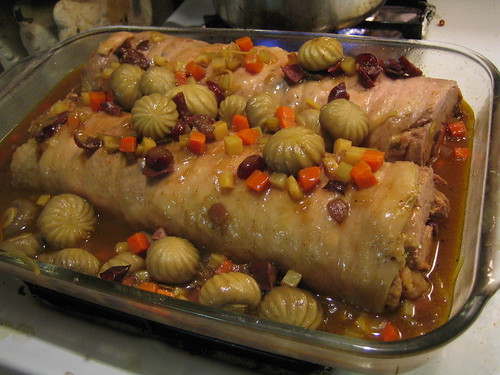
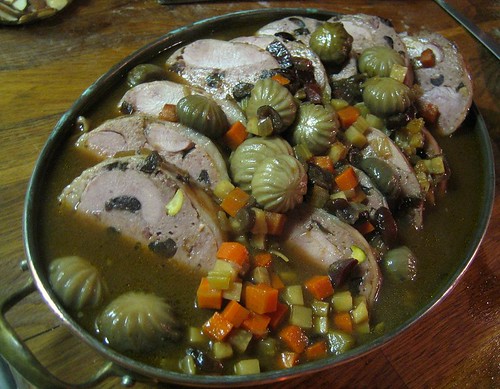
Turkey leg ballotines, in their reduced braising juices with some dried cranberries (rather than raisins), mushrooms and a couple sliced gizzards here and there.
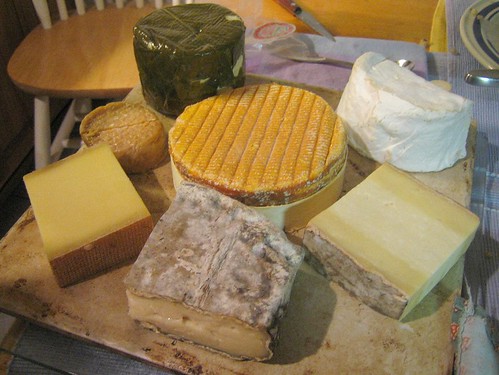
Cheese, clockwise from center: Livarot, France; Nettle Meadow Kunik, NY; Gorwydd Caerphilly, Wales; Twig Farm Square Cheese, VT; Tarantaise, VT; Mondegueiro, Portugal; Rogue River Blue, OR.
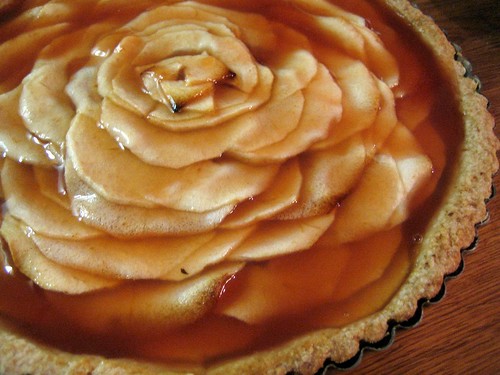
Apple tart with a nappage of my quince jelly with murmurs of rosemary and cinnamon.
Banda Aceh coffee.
Slight case of PTD (post-turkey depression) after having gestated the menu and formulations for the better part of 3 weeks. No glass breakage, pretty girls and early morning grazing on tryptophan & cheese scraps with fingers by the twilight of the frigidaire brings savory solace, albeit cold and perishable.
-
Ruhlman's book is awful. The brine percentages are far too high and the more accurate gram measurements are round up or down to even numbers. Grigson's book is noteworthy for its traditional recipes but for proper formulations based on percentages of initial meat, consider Len Poli, the definitive intertron cured meat resource. While Poli does not use curing salt (#1, sodium nitrite) for many of his fresh sausages, such salts (stable variations of salpêtre) will give the cooked meat a more pleasant pink appearance rather than brown. Shoulder by itself provides an acceptabe lean/fat ratio on its own for fresh sausage.



Christmas Dinner Menu Planning: The Topic
in Cooking
Posted
Yep. Pickled, naturally colored romanesco, yellow and purple cauliflower varieties. Aspic was colored with turmeric and blue food coloring, though yellow beet juice could have been used for the former.. A cross mold was cut into cardboard, lined with plastic and the yellow aspic poured in. The blue was poured into a dish and cut into quarters. Clear aspic was poured over the ham, the pieces aligned and more clear aspic spooned over. An triangular picnic-ham shaped pan/mold would have yielded better results. Next year.